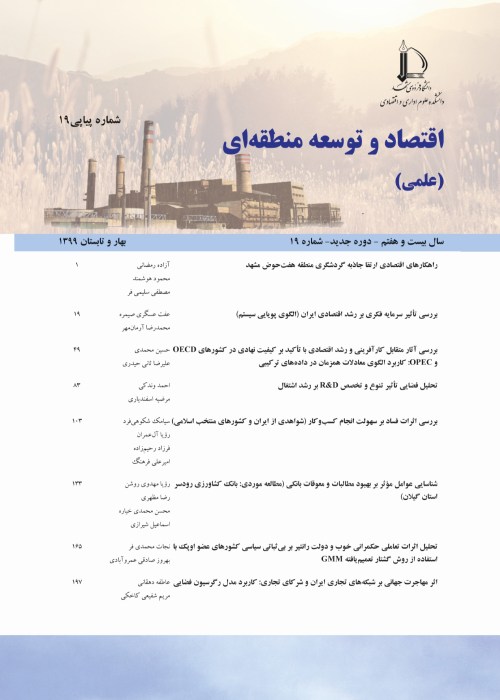Measuring Sustainable Development in the Provinces of Iran by Using the Ecological Footprint
Author(s):
Abstract:
Per capita Ecological Footprint (EF) or Ecological Footprint Analysis (EFA), is a means of comparing the consumption and lifestyles while checking this based on the nature's ability to account for this consumption. The tool can inform the policymakers by examining to what extent a nation uses more or less than what is available within its territory, or to what extent the nation's lifestyle would be replicable worldwide. The footprint can also be a useful tool to educate the people about the nature capacity and over-consumption with the aim of altering personal behaviors. Ecological footprints may be used to argue that many current lifestyles are not sustainable. Such a global comparison also clearly shows the inequalities of the resource use on this planet at the beginning of the twenty-first century. The ecological footprint analysis is now widely used around the Earth as an indicator of the environmental sustainability. It can be used to measure and manage the use of resources throughout the economy. It can be used to explore the sustainability of the individual lifestyles, goods and services, organizations, industry sectors, neighborhoods, cities, regions, and nations.
The EF is an attempt to quantify sustainability. The EF is based on the fact that every human activity has an impact on the environment through the resources required by these activities and the wastes generated from them. The logic dictates that a certain area of land is required to produce resources and sequester the wastes. What differentiates EF from other methods of sustainability assessment is that all human enterprises are reduced to a single dimensional area. Ecological foot-printing itself is based on several assumptions, the primary ones being as follows: It should be possible to identify the resources required by an activity and quantify the wastes generated by it. These resources and wastes can then be converted to the land area values that are representative of the bio-productive land required to produce the resources and sequester the wastes. The EF represents the critical natural capital requirements of a defined economy or population in terms of the corresponding biologically productive areas (Rees & Wackernagel, 1992). Once the values for the resource consumption are generated, biological yield conversion factors are used to translate the resource flows into land values. These conversion factors can vary greatly depending on how they are calculated as well as the bio-productivity of the regions on which they are based. The resources themselves are divided into several sections such as housing, transport, consumer goods etc. while this can also vary based on the methodology which is used. Once calculated, the per capita footprint can be compared to the global Earth-share, which is the average land availability per person on the earth.
Any overshoot above this figure is termed the environmental deficit that indicates the degree to which a population is living beyond the natures means. An easy method for visualizing what the EF means is the example of the modern city with the associated resources and waste flows. A large dome covers the city and the only thing that can travel through this dome is light. Naturally, the inhabitants do not survive and the structure of their society breaks down. Imagine, if it were possible to stretch this dome, it encompassed the bio-productive area outside this city. The EF of the city/region is the total area the dome would have to cover to be able to sustain itself indefinitely with the same levels of consumption. That is, the total area required to provide all the resources and sequester all the wastes indefinitely. Thus, EFs are practical indicators for the impact or environmental overshoot of the region since high economic demand equates with an excessive resource requirement. This means more land is required to maintain production, which in turn, results in the depleted capital stocks. Productive land itself is a good proxy for the natural capital since it can supply the vital ecosystem services.
Methodology
The ecological footprint accounting method at the national level is described in the Atlas Footprint 2010 or in greater detail in the calculation methodology for the National Footprint Accounts. The National Accounts Review Committee has also published a research agenda on how the method will be improved. There has been a difference in the methodology used by various ecological footprint studies. The examples include how the sea area should be counted, how to account for fossil fuels, how to account for the nuclear power, which data sources used, when average global numbers or local numbers should be used, when to look at a specific area, what areas for biodiversity should be included, and how imports/exports should be accounted for. However, as new footprint standards emerge, the calculation methodologies are converging.The EF is an attempt to quantify sustainability. The EF is based on the fact that every human activity has an impact on the environment through the resources required by these activities and the wastes generated from them. The logic dictates that a certain area of land is required to produce resources and sequester the wastes. What differentiates EF from other methods of sustainability assessment is that all human enterprises are reduced to a single dimensional area. Ecological foot-printing itself is based on several assumptions, the primary ones being as follows: It should be possible to identify the resources required by an activity and quantify the wastes generated by it. These resources and wastes can then be converted to the land area values that are representative of the bio-productive land required to produce the resources and sequester the wastes. The EF represents the critical natural capital requirements of a defined economy or population in terms of the corresponding biologically productive areas (Rees & Wackernagel, 1992). Once the values for the resource consumption are generated, biological yield conversion factors are used to translate the resource flows into land values. These conversion factors can vary greatly depending on how they are calculated as well as the bio-productivity of the regions on which they are based. The resources themselves are divided into several sections such as housing, transport, consumer goods etc. while this can also vary based on the methodology which is used. Once calculated, the per capita footprint can be compared to the global Earth-share, which is the average land availability per person on the earth.
Any overshoot above this figure is termed the environmental deficit that indicates the degree to which a population is living beyond the natures means. An easy method for visualizing what the EF means is the example of the modern city with the associated resources and waste flows. A large dome covers the city and the only thing that can travel through this dome is light. Naturally, the inhabitants do not survive and the structure of their society breaks down. Imagine, if it were possible to stretch this dome, it encompassed the bio-productive area outside this city. The EF of the city/region is the total area the dome would have to cover to be able to sustain itself indefinitely with the same levels of consumption. That is, the total area required to provide all the resources and sequester all the wastes indefinitely. Thus, EFs are practical indicators for the impact or environmental overshoot of the region since high economic demand equates with an excessive resource requirement. This means more land is required to maintain production, which in turn, results in the depleted capital stocks. Productive land itself is a good proxy for the natural capital since it can supply the vital ecosystem services.
Results And Discussion
The article is classified in several sections, Calculation of agricultural land shows: South Khorasan has the highest ecological footprint and the Fars lowest agricultural ecological footprint among Iran provinces. Calculation of energy land shows: Isfahan has the highest ecological footprint and the Sistan and Bluchestan lowest energy ecological footprint among Iran provinces. Calculation of Pasture ground land shows: south khorasan has the highest ecological footprint and the Qazvin lowest Pasture ecological footprint among Iran provinces. Calculation of Forest land shows: Tehran has the highest ecological footprint and the Sistan and Bluchestan lowest Forest ecological footprint among Iran provinces. Calculation of Build up land shows: south Khorasan has the highest ecological footprint and the Western Azerbaijan lowest Build up ecological footprint among Iran provinces.Conclusion
But this research results show that the inhabitants of Isfahan have footprint 2.412 acres for each person so Isfahan has the highest amount of the footprint between the provinces of Iran. Furthermore Sistan and Baluchestan's footprint was 1.962 hectares for each person that has the least amount of ecologic value between the provinces of IranKeywords:
Language:
Persian
Published:
Journal of Economy and Regional Development, Volume:23 Issue: 11, 2016
Pages:
1 to 47
magiran.com/p1662036
دانلود و مطالعه متن این مقاله با یکی از روشهای زیر امکان پذیر است:
اشتراک شخصی
با عضویت و پرداخت آنلاین حق اشتراک یکساله به مبلغ 1,390,000ريال میتوانید 70 عنوان مطلب دانلود کنید!
اشتراک سازمانی
به کتابخانه دانشگاه یا محل کار خود پیشنهاد کنید تا اشتراک سازمانی این پایگاه را برای دسترسی نامحدود همه کاربران به متن مطالب تهیه نمایند!
توجه!
- حق عضویت دریافتی صرف حمایت از نشریات عضو و نگهداری، تکمیل و توسعه مگیران میشود.
- پرداخت حق اشتراک و دانلود مقالات اجازه بازنشر آن در سایر رسانههای چاپی و دیجیتال را به کاربر نمیدهد.
In order to view content subscription is required
Personal subscription
Subscribe magiran.com for 70 € euros via PayPal and download 70 articles during a year.
Organization subscription
Please contact us to subscribe your university or library for unlimited access!




